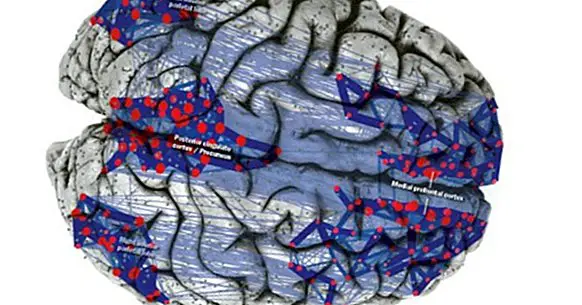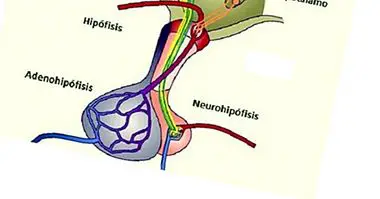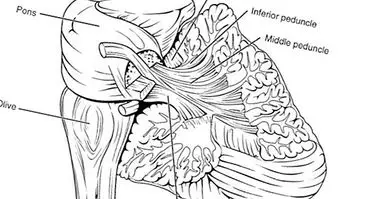The default neural network (RND) what happens in our brain when we dream awake?
It is usual to surprise oneself in full situation of self-absorption, daydreaming or, as they say in Spain, "thinking about the shrews". Even in situations where there is enough light and it is possible to detect movement around us, we have an amazing capacity to not think about anything, to ignore what happens in the immediate environment and, simply, to be carried away by a pleasant sensation of having no place to direct our attention.
These episodes in which we get lost in a stream of confusing and difficult to confuse sensations and thoughts do not happen by chance, since they have a neural basis in the normal functioning of our brain. The set of parts of the brain involved in this activity is called Default Neural Network (RND), and the research carried out to better understand this structure serves to better understand how we think and feel.
A not so random noise
For many years it has been believed that the brain is an organ whose level of electrical activity depends, basically, on whether it is functioning to solve cognitive tasks or not. From this point of view, for example, the neural machinery of our head would begin to really yield only at the moment when we try to remember something to answer an exam question, solve a puzzle, observe a person carefully or, for example , follow some instructions to assemble a piece of furniture.
Daydreaming: the brain is still functioning
But nevertheless, when we dream awake the neurons of our brain keep sending electrical impulses in a massive way . Previously it was believed that this neural activity of the areas not related to the bodily activities that keep us alive was simple noise, that is, electrical signals thrown at random and emitted in an uncoordinated way, like the snow that appears on the screen of a TV badly connected to your antenna.
Today, however, we know that this electrical activity does show well-defined patterns and there is coordination in it , which shows that these neurons continue to respond to a function in full stage of absorption. We also know that, surprisingly, when we start wandering and stop paying attention to our environment, our brain consumes almost the same energy as when we perform complex cognitive tasks that we have to perform consciously: only 5% less .
In some way, our brain is designed so that we can daydream, and it is likely that this activity has one or several concrete uses.
The dark energy of the brain
We know that brain activity continues to exist even when we stop paying attention to stimuli from the external world. Now ... what is all this activity for? What kind of neural processes are those that are taking all those resources that are not destined to solve issues related to the environment?
So far, little is known about this issue, and this is what has led some researchers to talk about the "dark energy of the brain", a type of activation that is known to be there but whose function is unknown .
Where does the neural network take place by default?
However, what we do know about this neuronal activity is that it is associated with very specific areas of the brain. This set of regions involved in these mysterious patterns of activation has been baptized with the name of Default Neural Network, Default Mode Network in English.
In other words, these recent investigations show that the human brain is prepared so that it does not diminish much its level of activity when our thoughts fall back on ourselves . In the moments when we are absorbed, we enter a "default mode" that we just begin to understand, and the default neural network is, in this way, the tissue of nerve cells that allow this to happen.
Exploring the default neural network
The default neural network is distributed in three zones: the medial area of the temporal, parietal and prefrontal lobes . These regions are activated in one way or another depending on whether we are carrying out tasks that require sustained focused attention on changing elements of our physical environment. Specifically, and although it may seem counterintuitive, the default neural network is activated when we begin to wander and enter into a state of self-absorption, and it goes off when tasks related to the external world require our attention.
Regarding the psychological aspect of what involves the coordination of the neurons of the neural network by default, we know that during the moments of reverie our thoughts, although imprecise and difficult to express verbally (in part because of the little attention we give them) , revolve around the idea of "I" and the imaginary situations that could happen in the future , more than revisions of past experiences. This leads us to believe that the function of the default mode may be related to the anticipation of events and our reaction to them, although this hypothesis must still be put to the test.
What does the default neural network tell us about the practice of daydreaming?
What we know about the neural network by default leads us to conclude that the nature of this kind of "mental wandering", or mind-wandering, is different from what we thought: it is not an activity that involves the blackout of large areas of the brain and the decrease in the coordinated activity of our neurons, but rather continues to be linked to a systematic and determined functioning of encephalic areas . In other words, when we dream awake, our brain does not deactivate, but enters into a different state of activation.
Our mind is not designed to "go blank"
So, it is difficult to assess to what extent our mind is blank if when this occurs our brain enters a kind of activation that consumes almost as much energy as the thought focused on external stimuli .
Investigating the functioning of the neural network by default can help us to better understand what we are talking about when we refer to the activity of "daydreaming" and it brings us closer the possibility of revealing to what useful aspects of brain functioning this set of neurons is associated and why logic is this type of activation.



















